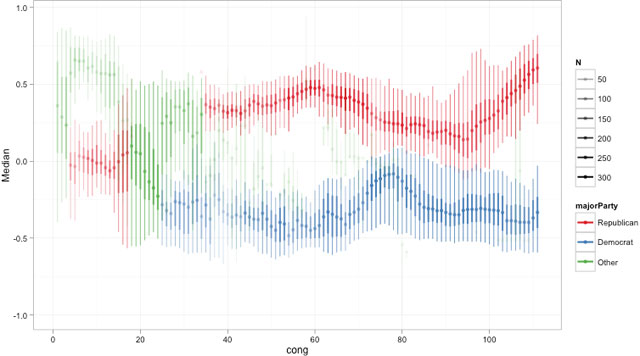Did Computers make gerrymandering calculations and complex elections more feasible, and thus lead to a serious disruption in state government and the operation of the House of Representatives?
Maryland has 1,787 voting precincts, 8 Congressional districts, and 47 legislative districts (some of which are further divided into districts electing one or two delegates to the House of Delegates). After the results of every census, the districts are redefined. Agreement of both houses of the legislature and the governor is required for passage of the new district definition. In some cases, the courts also have to approve the plan to assure that it is consistent with the Voting Rights Act and other national legislation.
Each party seeks to achieve party ends in the definition, notably by defining districts to maximize the number of its members elected to the Congress and to the state Senate and to the House of Delegates. On the other hand the definition of districts must maintain comparable numbers of citizens in comparable districts. It may not construct the districts in such a way as to reduce the ability of racial or ethnic minorities to elect representatives. Moreover, districts group precincts that are more or less closely located geographically.
The process is then to take the census data and combine it with voter registration data by party and voting data for recent elections, all disaggregated by precinct. Then working from the previously approved allocation of precincts to districts, move precincts in to and out of districts to achieve the desired political purpose while respecting the legal requirements on redistricting, and not making the districts look too odd.
Gerrymandering
In general, a party in power in the state will try to arrange districts so that it will try to define districts so that it enjoys a modest majority in as many as possible of the districts. These will be safe districts. If it can move some precincts that have shown a strong party majority into another district in which its candidates have not been safely reelected, while retaining a reasonable majority of its party voters in the original district, it will do so.
In obtaining a maximum of districts with modest but safe expected majorities for its party, it may tend to define a few districts that have large majorities for the other party -- thus being very safe for the other party's officials in those districts.
During Elections
The district definition has to be such that elections can be conducted. For example, sample ballots have to be developed. The sample ballot for each of the 1,787 precincts has to have not only the candidates for statewide offices, and for the Congressional and state legislative districts to which the precinct belongs, but also to all the country and city governments and all the non-partisan districts (such as judiciary or school board) to which that precinct may belong.
The voting machines in the district will have to be programmed for the same votes, and each registered voter in the precinct will have to receive by mail a copy of the right sample ballot. When voting is completed, the votes from the 1,787 precincts will have to be tallied in a timely fashion, and the winners of each election determined.
The Role of Information and Communications Technology
In high school, in 1954, I volunteered to spend the night in the Los Angeles City Hall working on the tabulation of the election results. That was the time of punched cards and tabulating machines, but before computers. There was a mob working to receive precinct results, store them appropriately, and pass the information to where it could be key punched and tabulated. Modern politics would not have been possible with that technology, technology which was state of the art 60 years ago.
Today in redistricting, politicians enjoy computers with information bases and geographic information system software which allow instantaneous visualization of the results of proposed changes in the location of precincts in districts. Indeed, with the support of ICT departments, they can program routines to test thousands of alternatives and select those meeting certain standards.
So too. computers have radically improved the ability of election officials to efficiently generate many different sample ballots meeting the needs of all their precincts, to program voting machines, to produce individualized mailings of sample ballots, and to tabulate ballots.
Thus improvements in computer technology have made it possible for a party in power to gerrymander districts far more elegantly and to more effectively achieve its competitive purposes.
The Results
37 states now have single party control of both the legislature and the governor, up from 20 in 1990. Once a party gains control of a state, it is likely to keep control of the state. Perhaps the greater technical ability to gerrymander for party benefit contributes to that single party control of state government and its continuity.
Only 62 of 433 representatives to the House of Representatives (14,5%) were elected by less than a 54 % majority in 2012. Most Congressional districts are safe for their incumbents and their incumbents' party. The party primary is increasingly more important than the final Congressional election. This has been deemed to be an important reason for the increasing ideological division within the Congress. Perhaps the greater technical ability to gerrymander for party benefit contributes to increased partisanship in Congress.
Ideologies of Members of Congress 1789 to 2010
 |
| Source |
An Aside
Not really related, but I note that speeches in Congress have used increasingly simple language (as measured by the grade level needed to fully understand the text) since 2006. The effect is especially visible in the 110th and 111th Congresses, during the crash that started the Great Recession and its aftermath. Impact of the economy, the Internet or both?
 |
| Source |

No comments:
Post a Comment